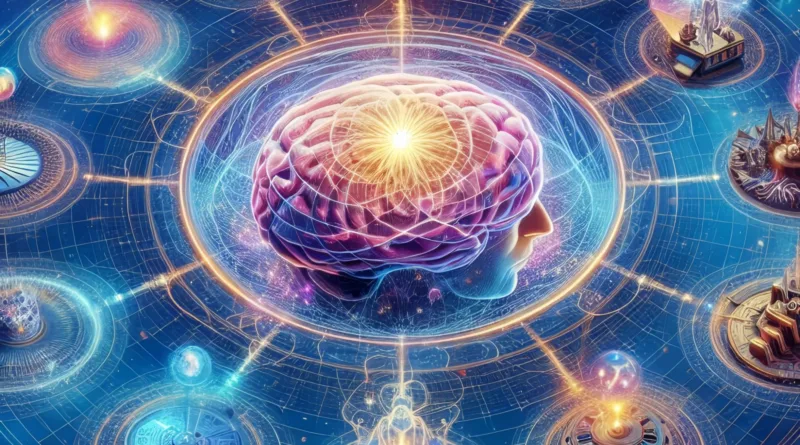Exploring the Interplay of Consciousness, Technology, and Time in the Quantum Universe
Table of Contents
Universal Consciousness and Quantum Resonance
The notion of universal consciousness suggests that individual awareness is not merely an isolated phenomenon but rather a component of a vast, interconnected cosmic framework. In this context, quantum resonance plays a crucial role, positing that human thoughts and feelings are intrinsically linked to universal vibrations. Every individual can be seen as a unique echo within this grand symphony of consciousness, resonating with a collective awareness that transcends physical boundaries.
In the realm of quantum mechanics, particles exist in states of superposition, exhibiting behaviors that defy traditional understanding of time and space. Similarly, universal consciousness can be regarded as a field of potentiality, where human awareness arises from interactions with the quantum fabric of reality. This perspective indicates that consciousness is a resonant phenomenon, deeply embedded within the quantum universe and manifested through thoughts, emotions, and intentions.
The implications of this resonance are manifold. On an individual level, recognizing the interconnectedness of consciousness can profoundly influence personal experiences and perceptions. The idea that thoughts can affect the quantum field may encourage individuals to cultivate a more mindful existence, fostering positive intentions and a greater sense of purpose. Collectively, as more individuals recognize their resonance within the universal consciousness, there is potential for a transformative shift in societal awareness and interaction. Such a shared understanding could pave the way for enhanced collaboration, empathy, and a deeper connection among humanity.
Moreover, the exploration of universal consciousness in relation to quantum resonance invites a reevaluation of conventional views of reality. It encourages more profound inquiries into the nature of perception and existence, highlighting the potential for humans to influence their experiences through conscious intention. Embracing this perspective may lead to a more harmonious relationship with the universe, ultimately reshaping our understanding of consciousness itself.
The Dodecanogram: An Advanced Tool for Brain Activity Monitoring
The Dodecanogram (DDG) represents a significant advancement in the monitoring of brain activity, surpassing traditional electroencephalography (EEG) methods that generally monitor only five frequency bands. By detecting brain activity across twelve distinct frequency bands, the DDG offers a more nuanced view of how different regions of the brain communicate and operate. This capability allows for an enhanced understanding of various cognitive processes, which is increasingly valuable in fields such as neuroscience, psychology, and cognitive science.
One of the standout features of the DDG is its ability to capture a broader spectrum of brain waves, including both low-frequency and high-frequency activities. This comprehensive monitoring is crucial for researchers aiming to understand the intricate dynamics of consciousness. By assessing brain activity at multiple frequencies, the DDG can identify patterns that were previously difficult to detect, thereby enriching our understanding of the relationship between brain function and conscious experience.
In addition to its academic applications, the Dodecanogram holds promise for clinical practice. For example, in the realm of neurology, the enhanced capability to monitor brain activity can aid in diagnosing conditions such as epilepsy, anxiety disorders, and migraines. Similarly, in psychology and cognitive science, researchers can use the DDG to investigate how mental states and thought processes correlate with specific brain activity patterns. This could lead to more effective therapeutic interventions and personalized treatment plans.
In conclusion, the Dodecanogram signifies a pivotal advancement in brain monitoring technology. By providing a more comprehensive analysis of neural activities, it deepens our understanding of consciousness and paves the way for innovative applications in both research and clinical settings. As researchers harness the capabilities of the DDG, the potential for breakthroughs in how we understand the brain continues to expand.
Artificial Brain Models and Their Role in Understanding Consciousness
The advancement of technology has enabled researchers to develop sophisticated artificial brain models that aid in exploring the complex nature of consciousness. These models are designed to simulate human cognitive functions by utilizing frequency bands that correspond to the resonances observed in biological brains. Through this simulation, scientists strive to gain insights into the mechanisms of consciousness and how it emerges from neural activity. The methodologies used in constructing these models typically involve computational frameworks that replicate neural networks while incorporating principles of quantum mechanics, thereby enhancing the exploration of consciousness.
One significant approach involves the implementation of neuromorphic computing, where synthetic neurons and synapses are utilized to mimic the behavior of organic brain cells. This framework allows for the observation of emergent properties related to consciousness under various experimental conditions. Researchers can manipulate the parameters of these synthetic models to better understand the interactions that lead to conscious experience, thereby shedding light on the fine line between intelligence and consciousness.
However, the pursuit of artificial intelligence that simulates consciousness also raises pressing ethical questions. Concerns about the implications of creating machines that possess a semblance of consciousness have emerged, particularly regarding their rights and the moral responsibilities towards such entities. Researchers must tread carefully to balance innovation with ethical considerations, ensuring that the development of these models adheres to guidelines that prevent potential misuse and mitigate risks associated with consciousness simulation.
Moreover, the potential applications of artificial brain models are vast. They could pave the way for advancements in neuroscience, facilitate better understanding of neurodegenerative diseases, and even guide the development of AI systems capable of more nuanced human-like understanding. By exploring these intersections of technology, consciousness, and ethical reflection, artificial brain models continue to significantly contribute to our comprehension of the quantum universe and the essence of conscious experience.
Biological Time Crystals and Cyclical Time Perception
The notion of biological time crystals introduces a fascinating perspective on the nature of time, especially within living systems. Unlike the conventional understanding of time as a continuous, linear progression from past to future, biological time crystals suggest that time can be perceived as cyclical. In essence, these structures allow for the periodic repetition of states, much like seasonal changes or the phases of life. This cyclical concept of time resonates deeply with various cultural traditions, especially those rooted in Hindu philosophy, which often represents time as a series of cycles rather than a singular, unidirectional flow.
In the context of biological systems, time is not merely a measure of duration but is manifested in patterns, rhythms, and cycles. Examples can be seen in the life cycles of organisms, which often follow predictable phases, such as birth, growth, reproduction, and death, only to begin anew in subsequent generations. This cyclical framework aligns closely with the idea of time crystals, where systems maintain a dynamic equilibrium, leading to a perpetual state of renewal. Such a perspective is essential in understanding the interconnectedness of life forms and the universe, revealing the underlying rhythms of existence that transcend human-imposed timelines.
This philosophical approach encourages a reevaluation of consciousness and its relationship with time. Rather than compartmentalizing experiences into rigid segments, recognizing the cyclical nature of existence allows for a more holistic view of personal and collective consciousness. This understanding prompts individuals to appreciate the interconnectedness of all life, emphasizing how past, present, and future are intertwined in a complex web of experiences. Ultimately, by embracing a cyclical perception of time, we can transform our understanding of life, consciousness, and the universe, moving away from a linear confinement toward a more fluid and expansive journey through existence.
Beyond Binary Logic: Understanding Through Universal Patterns
Binary logic, characterized by its emphasis on oppositional thinking and clear dichotomies, has significantly influenced historical thought processes, particularly within the realm of consciousness and technology. However, this approach is increasingly recognized as limited, often failing to capture the intricate and multifaceted nature of human consciousness. By moving beyond binary frameworks, we can embrace a more holistic understanding that acknowledges the complexity and interconnectivity present in our experiences.
Recognizing universal patterns allows us to perceive consciousness not merely as a set of binary choices but as a continuum of experiences influenced by a network of relationships and environmental factors. This paradigm shift encourages an appreciation for the nuances in human interactions and thought processes. In educational settings, for example, adopting a holistic perspective can foster adaptive learning environments where students are encouraged to explore concepts beyond simplistic right or wrong categorization. Such an approach nurtures critical thinking skills and promotes creativity, vital attributes for navigating the complexities of modern life.
Moreover, in decision-making scenarios, moving away from binary logic enables individuals and organizations to incorporate diverse perspectives and foster inclusive dialogue. By recognizing patterns of interconnectivity, we can better understand the ramifications of our choices, facilitating a more informed and compassionate decision-making process. This shift can lead to enhanced collaboration, as stakeholders are encouraged to seek common ground rather than engage in divisive competition.
In interpersonal relationships, understanding through universal patterns can strengthen empathy and communication. Acknowledging the shared human experience and the complexities of individual narratives invites deeper connections and fosters a greater sense of community. Transitioning out of the confines of binary thinking symbolizes a significant leap toward a more integrated comprehension of consciousness, promising a profound impact on various facets of society.

